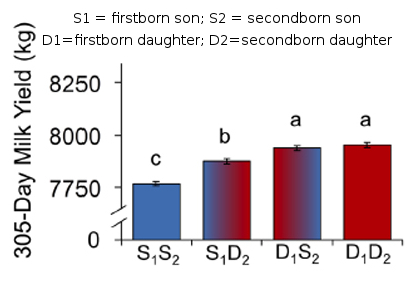
Milk production depends on sex of firstborn calf
 I don't usually post found facts from the internet here, but this study
was just too good not to share. Scientists studied the lactation
records from 1.5 million cows, and discovered that a cow's milk
production depends on whether her first child is a girl or a boy.
The cow produces 2.7% more milk if her first calf is female.
I don't usually post found facts from the internet here, but this study
was just too good not to share. Scientists studied the lactation
records from 1.5 million cows, and discovered that a cow's milk
production depends on whether her first child is a girl or a boy.
The cow produces 2.7% more milk if her first calf is female.
Ed Yong goes on to say:
In other words, it makes a
big difference for the entirety of the dairy cow's life whether her
firstborn is a son or daughter. And that doesn't have to be left
up to chance. Yong continues:
On the backyard level,
where dairy-cow owners are probably breeding their own replacement milk
cows, it's worth knowing that a heifer whose firstborn is a son isn't
going to be your most productive cow. Maybe that's the one to
sell, and you should try again with her daughter?
Want more in-depth information? Browse through our books.
Or explore more posts by date or by subject.
About us: Anna Hess and Mark Hamilton spent over a decade living self-sufficiently in the mountains of Virginia before moving north to start over from scratch in the foothills of Ohio. They've experimented with permaculture, no-till gardening, trailersteading, home-based microbusinesses and much more, writing about their adventures in both blogs and books.
Want to be notified when new comments are posted on this page? Click on the RSS button after you add a comment to subscribe to the comment feed, or simply check the box beside "email replies to me" while writing your comment.

...or the one to keep. A family cow that produced less than industry standards would be ideal. Two gallons+ a day for the raising of the calf, and the rest for home dairy production. Dairy cow genetics from the 50's were about right, nowadays they have taken breeds that used to produce 5 gallons per day and bred them up to 10 gallon a day cows. That is too taxing on the cow.
Cheese, yogurt, butter, milk and beef all from one cow. Pretty sweet really if you have the grass
I forgot to add that historically heifers from first calf heifers were not desirable and thought to be not worth keeping in the herd. Many used to become family cows and not kept for the milking string. This is due to the fact that heifer herself is still growing and has not reached full dentition while being pregnant.
I've had a few of those myself and they make perfect family cows because of lower production. Interesting study Anna!